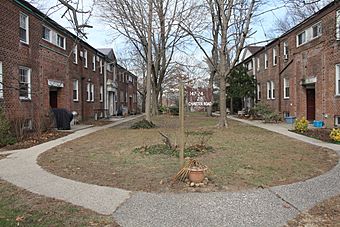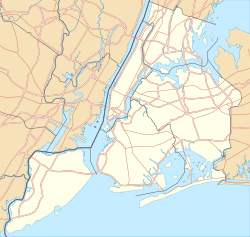Parkway Village (Queens) facts for kids
Quick facts for kids |
|
|
Parkway Village
|
|

Two buildings enclosing a landscaped court
|
|
| Location | Bounded by Union Tpke., 150th St., Goethals Ave., Parsons Blvd., Grand Central Parkway, & Main St. in Kew Gardens Hills, Queens, New York City |
|---|---|
| Area | 35 acres (14 ha) |
| Built | 1947 |
| Architect | Leonard Schultze and Associates; landscape by Clarence Combs |
| Architectural style | Neo-Georgian, "modernized Colonial" |
| NRHP reference No. | 12000052 |
| Added to NRHP | February 28, 2012 |
Parkway Village is a special group of apartment buildings in the Briarwood area of Queens, New York City. It has 675 homes spread out over a large area, like a big garden. It was finished in 1947. It was built to help employees and leaders from the United Nations find a place to live. Many of them had trouble finding homes elsewhere because of unfair rules about race.
Contents
A Home for the United Nations
When the United Nations (UN) started working in New York City in 1946, people from all over the world came to join. Many of these people were not white. At that time, most housing in the area had unfair rules about who could live where based on race. This made it very hard for non-white people to find homes.
The UN tried to find housing for its workers in other new apartment buildings. But these places still allowed companies to refuse housing based on a person's race. Even though these places didn't openly say they were unfair, only white people lived there for many years.
Many UN employees protested this unfair situation. So, the UN decided to cancel its agreements with those apartment complexes. Still needing homes for its workers, the UN then made a deal with Parkway Village, which was being built at the time.
A Diverse Community
Because the UN rented most of the apartments first, it could give homes to its employees without caring about their race or where they came from. This made Parkway Village a very special and diverse community for its time. It was unusual to see people of different backgrounds living together.
The location was also very handy. It was close to the UN's temporary headquarters, which was the building now known as the Queens Museum. Many people thought the UN would build its main headquarters there. However, the UN's permanent headquarters was finished in 1952 in Manhattan.
The UN's direct involvement with Parkway Village ended in 1952. But many of its employees kept living there. Even 30 years later, about a quarter of all residents were still UN workers.
Famous Residents
Ralph Bunche, an African American diplomat, lived at Parkway Village from 1947 to 1952. He helped create the UN and won the Nobel Peace Prize in 1950. Bunche was one of the people who spoke out against the UN's first plans with unfair apartment buildings. After leaving Parkway Village, he moved to a private house nearby that is now a special historic site.
Around the same time, two other important people were drawn to Parkway Village because of its unique international feel. Civil rights leader Roy Wilkins and activist Betty Friedan both lived there in the early 1950s.
What Parkway Village Looks Like
Parkway Village has 109 buildings. These buildings take up only a small part of the land, about 16%. The rest of the area is beautiful landscaped grounds with lots of green space. Each building is two or three stories tall. They are made of red brick. Their style is called "neo-Georgian" or "modernized Colonial."
The Architects and Designers
The main architect was Leonard Schultze. Before this, he was known for designing fancy hotels, like the famous Waldorf-Astoria. But in the 1940s, he started designing large apartment complexes for middle-income families.
The landscape designer was Clarence Combs. He had worked on many other big projects, including Jones Beach State Park. Robert Moses, a very powerful parks commissioner, helped arrange the money and the lease for Parkway Village with the UN. He likely suggested Combs for the landscaping work.
Because of its special design and its important history, Parkway Village was added to the National Register of Historic Places in 2012. This means it's recognized as a place worth protecting.




